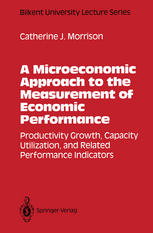

Most ebook files are in PDF format, so you can easily read them using various software such as Foxit Reader or directly on the Google Chrome browser.
Some ebook files are released by publishers in other formats such as .awz, .mobi, .epub, .fb2, etc. You may need to install specific software to read these formats on mobile/PC, such as Calibre.
Please read the tutorial at this link: https://ebookbell.com/faq
We offer FREE conversion to the popular formats you request; however, this may take some time. Therefore, right after payment, please email us, and we will try to provide the service as quickly as possible.
For some exceptional file formats or broken links (if any), please refrain from opening any disputes. Instead, email us first, and we will try to assist within a maximum of 6 hours.
EbookBell Team

0.0
0 reviewsThis text is designed to provide a comprehensive guide to students, researchers, or consultants who wish to carry out and to interpret analyses of economic performance, with an emphasis on productivity growth. The text includes an overview of standard productivity growth measurement techniques and adaptations, and data construc tion procedures. It goes further, however, by expanding the tradition al growth accounting (index number) framework to allow consider ation of how different aspects of firm behavior underlying productivity growth are interrelated, how they can be measured con sistently in a parametric model, and how they permit a well-defined decomposition of standard productivity growth measures. These ideas are developed by considering in detail a number of underlying theoretical results and econometric issues. The impacts of various production characteristics on productivity growth trends are also evaluated by overviewing selected methodological extensions and em pirical evidence. More specifically, in the methodological extensions, emphasis is placed on incorporation of cost and demand characteristics, such as fixity and adjustment costs, returns to scale, and the existence of market power, into analyses of productivity growth. These character istics, generally disregarded in such analyses, can have very important impacts on production structure and firm behavior, and thus on economic performance. They also provide the conceptual basis for vii viii PREFACE measures that are often used independently as indicators of economic performance, such as investment, capacity utilization, and profit measures.